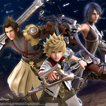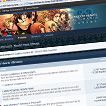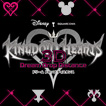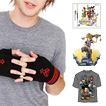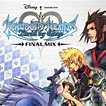KH Re:coded Ultimania Interviews
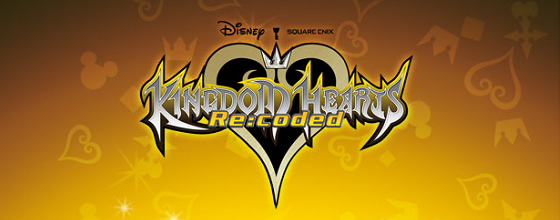
Howdy folks!!
Several of the interviews from the Kingdom Hearts Re:coded Ultimania book have been translated and they offer lots of information about the development of Recoded through the experiences of the development team!
The interviews were translated by gold_panner of Heartstation.org:
Takahito Ebato: Planning Director
From: Tokyo Development Team
Previous titles: Coded
What is something you paid careful attention to in this title?
I wanted to make a game that could be looked at, played and enjoyed many many times, like a Disney Land attraction. I consider the bug blocks, system area, sidescroll action, 3D shooting etc as attractions that you should be able to adventure in through each world.
Was there something you were thinking to change since the mobile phone version of Coded?
Because the controls were hugely improved, I was thinking I wanted to realize marvelous action on the DS. By adjusting and incorporating the Deck Command system and ShotLock options from Birth by Sleep, as well as adopting auto-jump and the like, I think it turned into an action RPG that can be played by a wide range of gamers.
What was the very hardest thing?
Not having any time. Because the amount of time between Coded for the mobile phone and Re:Coded for the DS was short, we were late in drawing up modified points for the DS version and new plans.
If you have an unforgettable memory from during development, please share it with us.
I will never forget the sashimi we ate at a bar we randomly went into on a business trip to Sapporo to make arrangements with h.a.n.d (the developement company who were given charge of producing this title). It was both huge and delicious.
What’s the best part about this title?
It is the total balance that makes everyone who bought the game able to feel satisfied, from clearing the game to running through it. I really can’t narrow down the best part!
Secret of this title that only he knows:
When developing the mobile phone version, I trialled so many different boss fights. There was also a version of the boss fight for Olympus Coliseum in which your health would shave down as you clashed with enemies and allies alike.
Tai Yasue – Planning Supervisor
From: Osaka Development Team
Previous titles: Re:Chain of Memories, Birth by Sleep, Vagrant Story, Tetra Master, Musashi: Samurai Legend
Please tell us how you came to join the development team for this title.
Nomura contacted me around Janurary 2010, saying he wanted me to think about battles, and the growth component in particular, for this title. At the time, including me, three people from the Osaka team that worked on Birth by Sleep had joined, and by the end the title turned into something that over 20 staff members were needed to make. Working under Nomura always means a boundless dream spreading before me, and a boundlessly harsh road to develop it (laughs).
What is something you paid careful attention to in this title?
My goal was to greatly deepen the customization factor of the growth system, while making the content easily accessible. At the end of much agonizing over a superb balance, I arrived at the plans for the Matrix System and Overclock System. With these two systems, the more a player fights the wider the range of play becomes, so please by all means take the time to play through slowly and carefully.
Next time you lend a hand to a Kingdom Hearts title, what would you like to try?
I can’t speak in detail about the new title, but I want to surprise everyone with a unexpected growth system that is different from Re:Coded and Birth by Sleep. While coming up with the plans, I always keep some kind of theme in mind, and right now the theme I’m crazy in dreaming of is ‘making contact’. Making contact with something in a dream.
Secret of this title that only he knows:
Scratch Card was originally something we planned to use in Birth by Sleep Final Mix. After proposing it to Nomura, he said, “I definitely want the scratching on a touch screen,” and it ended up being used in this title.
Masaru Oka – Planning Director: Cutscenes
From: Tokyo Development Team
Previous Titles: KH1, KH1 Final Mix, KH2, KH2 Final Mix, 358/2 Days, Coded, Birth by Sleep, FFVII, FFVIII, FFX, FFXIII, -FFVII- Crisis Core, Treasure of Rudra
What is something you paid careful attention to in this title?
It was changing the types of still images of the characters we used for conversation scenes, seeing as there was a limit, and directing the 2D cutscenes for rich expression.
Please tell us why you went with composing the cutscenes of still images.
In the beginning we considered having cutscenes in 3D like 358/2 Days, but we felt a limit to the power of expression in those. Then, Nomura proposed, “What about using still images like the cutscenes in The World Ends With You?” From then on, the direction we were taking the expression in was settled. With the staff in charge of motion as our pivot, we repeatedly examined methods of expression, including having the backs of the characters in the still pictures, and ways to make the depth and movement of the characters felt.
What was the very hardest thing?
In scenes where many characters appear at once, ensuring space for the placing of their images and their manner of popping in felt a lot like doing a puzzle.
If you have an unforgettable memory from during development, please share it with us.
After completing the Japanese version, when production of the overseas version had started, it was necessary to check each of the memory words in Wonderland. As I checked them time and time again, I began to understand European language just a little. Only the memory words in the game, though…
Secret of this title that only he knows:
During development, we used Chip from Chip and Dale as a temporary portrait for the still images. In the scenes where Cerberus and Rock Titan were meant to appear, Sora would be shivering in fear at Chip. The gap was pretty funny.
Daisuke Watanabe – Scenario Supervisor
From: Tokyo Development Team
Previous Titles: KH1, Chain of Memories, Coded, FFX, FFX-2, FFXII, FFXIII
What is something you paid careful attention to in this title?
In the early planning stages of the mobile phone version of Coded, I helped create the general plot. Because it was going to be transmitted in installments, I paid careful attention to having things develop so that people would be interested in the continuation every time, thinking, “What will happen next!?”
What kind of influence did the premise, ‘adventuring in worlds of data,’ have on the scenario?
In an imaginary data world, things that could never happen in reality can be realized, and so it was easy to have unexpected twists unfold. On that note, though, a story in which ‘anything can happen’ gets disorganized, so balancing the tolerance level of material was something I agonized over.
What was the very hardest thing?
If I were to have thought that there wouldn’t be much work to do because it was a ported title, I would have been caught off guard; with adding more and more new gameplay, I had to think of many new ability and item names, and write bunches of explanations… It was tough, but I’m glad that I could be useful in powering up the title. However, I do have a feeling that I wrote the default friend in Mingle Mode’s line in a bit of a silly mood.
If you have an unforgettable memory from during development, please share it with us.
This development team had a comparatively small number of people, and I felt a sense of unity amongst us. I have lovely memories of going ahead with work while making an effort to consult (and sometimes chat) with h.a.n.d in Sapporo every day over chat.
Secret of this title that only he knows:
Originally, the true identity of the black-coated person who appears in Castle Oblivion was not ‘????’ (Roxas), but someone else. Though their name has the same number of characters as Roxas and the second character is ‘ku’.
Note: In Japanese, Roxas’ name reads like Ro-ku-sa-su and Axel’s like A-ku-se-ru, implying that the other character was Axel.
Koichi Akiyama – Art Director
From: Tokyo Development Team
Previous Titles: Coded, Monotone, Code Age Brawls
What is something you paid careful attention to in this title?
I paid meticulous care in how to convey the image of the concept of this title, ‘worlds of data,’ without destroying the delicate image of the worlds in the Kingdom Hearts series. The Bug Blocks in particular are of a rather different nature to the series, but I think I was able to blend them in well.
Was there something you were thinking to change since the mobile phone version of Coded?
In the original version of Coded, because of the mobile phone’s limited 3D capabilities, most of the characters moved around in animations based on 2D images. Because of that, amongst much sorrow, I had to abandon 3D effects trailing the Keyblade and enemy attacks. In this title all the characters are now in 3D, and I was able to establish trail effects and hitting effects for the Keyblade. I think that the finished effects arrived at a pretty high quality compared to other DS games.
What’s the best part about this title?
When reading the scenario, I unexpectedly got goosebumps at the part where we find out about Sora’s connection to the Neo Darkside you fight at the end of the latter Hollow Bastion (laughs). Everyone, please see that part with your own eyes.
Secret of this title that only he knows:
When developing the mobile phone version, for most of the staff it was their first time working on the Kingdom Hearts series, and it was difficult getting a grip on the unique designs and images of the worlds. The machine that reads Jiminy’s Journal in a cutscene was a painstaking work that I drew after collecting together Disney-related material, chosen from over twenty designs.
Ryouto Shinzato – 3D Backgrounds
From: Tokyo Development Team
Previous Titles: Coded, FFVII- Before Crisis
What is something you paid careful attention to in this title?
“How do I express the appeal of Coded on the DS?” “How do I add new, not simply remake, appeal?” Those are things I paid careful attention to.
What were the technical improvements from 358/2 Days?
I made pretty much everything, such as camera movement and collision control (judgment of collision between polygons) and the like, from scratch all over again for Re:Coded.
Please tell us the concept for the scenery in the gameplay area.
Concept-wise it was all, ‘inside buggy data,’ but I expressed it so that even people who didn’t know many details about the premise of this title would understand instinctively in a flash.
Which is your favorite scenery?
A map that could be called symbolic for KH1; Traverse Town. I also like all the boss stages that look like a ball that changes speed.
What was the very hardest thing?
Olympus Coliseum, with it’s huge number of maps, was tough. The staff on scenery worked hard, and we were adjusting right up until the very end of development. I think those parts came out very rewarding.
If you have an unforgettable memory from during development, please share it with us.
In order to develop this title, the planning group went on a long business trip and we didn’t see them for about half a year. We were surprised when they came back two sizes bigger.
Secret of this title that only he knows:
In the early plans for the Bug Blocks there were going to be several dozen types, but there were too many and the rules got a bit complicated, so we made selections until it fell to the present number.
Mai Okauchi – Art Director: Character
From: Tokyo Development Team
Previous Titles: KH2, KH2 Final Mix, 358/2 Days, Birth by Sleep, Final Fantasy Dissidia
How many 2D images for the conversations between characters, in total, did you draw?
Including every single character, we completed 400 patterns, front and back, in total. Among those, 55 patterns were just of Sora and the King; they made up 14% of the whole job.
Which is your favorite 2D graphic?
After all is said and done, it’s definitely the protagonist, Sora. Thanks to Sora’s ever-changing expressions, rich in emotion, even when we were making the 2D graphics we could have great deal of fun as we worked. This is true for any character, but the pen progresses nicely when drawing a smile. Namine’s sad expressions give her such a sad face, the poor thing, so when she’s smiling instead, I feel relieved somehow. My favorite Disney character is the graphic of surprised Alice with one foot in the air. I think it’s one that really expresses her charming personality.
If you have an unforgettable memory from during development, please share it with us.
Once, the people from the cutscene team looked at the graphics we’d prepared, and pointed out “Selphie is getting a bit sexy, isn’t she? (laughs)” We took a look and saw that Selphie’s legs were one size fatter because of a mistake we’d made, and thanks to her plump thighs she really did give quite an adult impression… We were all pretty nervous and fluttery over our carelessness.
Secret of this title that only she knows:
For Jiminy’s Journal, we used the polygon model we made for KH2, and whenever a new sentence was added for this new game, we added a new page. So, looking at the contents would bring back all kinds of memories of the old days.
Satoshi Ohtani – Art Director: 3D Characters
From: Tokyo Development Team
Previous Titles: Coded, -FFVII- Before Crisis, Romancing SaGa: Minstrel Song
What kinds of things were you careful with, making KH1 graphics reappear on the DS?
I did my best to make Sora and Riku move more crisply than in the original KH1, and not let the quality fall. Representing their faces and hair were particularly important. The most difficult individual character was Cloud. He has heaps of pointy parts and accessories, and I remember being careful as I made him, wondering how I could make them show up nicely on the DS. Though, despite being so much work, he hardly appears at all…
What was the very hardest thing?
The maximum number of polygons has to be reduced by about 1/5 for the DS compared to the PS2. Disney characters like Donald and Goofy have lots of round shapes, so trying to faithfully recreate them results in a huge number of polygons, and using up that share reduces the number of enemies that can appear at once. It was fairly difficult trying to make the largest number of enemies appear while maintaining the shapes of the original characters.
What’s the best part about this title?
I recommend all the boss fight scenes, but if I have to pick one, I guess the Trick Master battle in Wonderland. It’s a battle that unfolds with dizzying speed as the camera spins around, and the up-tempo music matches perfectly. I think it gives a very pleasant feeling.
Secret of this title that only he knows:
Sora and Riku’s sizes are pretty much the same as in KH1 and Coded, but the size of the enemies adjust depending on the camera angle and number of them that show up. Things like Rock Titan double in size between cutscenes and in-battle.
Munenori Shinagawa – Animation Director
From: Tokyo Development Team
Previous Titles: KH2, KH2 Final Mix, Re:Chain of Memories, 358/2 Days, Coded, Birth by Sleep
What is something you paid careful attention to in this title?
Making the characters move as close to how they did in KH1 as possible. When I played a demo version made in the early days of development it looked just like playing KH1 on the DS, so I decided I wanted to make something that gamers who had played KH1 could also find satisfying.
What did you pay attention to when reproducing the basic motion of KH1?
For Sora’s motion in particular, I was very thorough in creating it, right down to the fine details. Because it was adjusted many, many times until I was satisfied, I unfortunately put a lot of hardships on the developers at h.a.n.d, but I am very grateful for the satisfaction with everything I received in return.
If you have an unforgettable memory from during development, please share it with us.
In the early days of development, I have good memories of when all the staff were thinking about, “What are we going to do for the pose and visual expression of the characters used in the 2D cutscenes?” The time I showed Nomura a demo version in the middle of the night and he gave me the OK is another particular memory I hold.
What’s the best part about this title?
The motion in the movies is a must-see! The characters have facial expression in all the scenes, and all the motion was brought to life without any misappropriated elements. Amongst the successive titles in this series, this is the one I’ve spent the most time and energy on. Please explore every nook and cranny of the game nice and carefully!
Secret of this title that only he knows:
We made a great many still images of each character for use in the conversation cutscenes, and there are also many outtake poses. Sora in particular has the biggest number of outtakes, and some of those are poses I’d find myself laughing at.
Naoyuki Ohashi – Lead Programmer
From: Tokyo Development Team
Previous Titles: Coded, -FFVII- Before Crisis
When you heard the theme of the game, ‘debugging data worlds,’ what were your impressions as a programmer?
They’re named ‘bugs,’ but when I first saw the premise my impression was closer to ‘virus’. In practice, debugging work isn’t as simple as hitting with a Keyblade…
Was it hard work making all the different kinds of gameplay for the boss stages?
Yes. It shifts in-game to completely different gameplay styles, so it felt like I was completing content for more than one different game.
What was the very hardest thing?
I thought that I’d reuse the basic gameplay from 358/2 Days for a little while longer, but there were so many additional factors like Bug Blocks that I had to remake pretty much everything anew.
If you have an unforgettable memory from during development, please share it with us.
In the beginning, the project was just a port of the mobile phone version, but as development went on, before we realized it, it became a complete remake. Only thing that didn’t change was the schedule.
What’s the best part about this title?
The gameplay is entirely new, having evolved from taking the popular parts of 358/2 Days, Coded and Birth by Sleep. The options set-up is also solid, which means I’m sure you will be able to play with a control system that fits you.
Secret of this title that only he knows:
The movies in the DS version of Re:Coded are beautiful enough, but depending on the model of mobile phone, when it comes to final performance, the original Coded can be viewed in higher resolution than the DS version.
Yoko Shimomura – Music
From: Studio Midiplex
Previous Titles: KH Series, Super Mario RPG, Parasite Eve, Legend of Mana
Please tell us about the new music appearing for the first time in this title and the mobile phone version of Coded.
The Debug Mode theme first appears in Coded (In Re:Coded, this track plays while you are searching for the bug door). There are three new themes in total appearing in the new title; System Area field theme and battle theme, and the background music for the Matrix screen. The theme for the Bug Room in System Area was an arrangement by Mr. Noda (Noda Hirosato), but he left the atmosphere of the original piece, and the buggy feeling is amazing!
What kind of requests did Nomura make concerning the new music?
For System Area, he requested it had the image of a techno-style old-school game. For the Matrix screen he wanted “a fun pop track, close to the image of the gummi ship editor in KH2. It’s an electric circuit, so I’d love it if you added in sounds that feel like light and electricity.” That sort of thing. In fact, this was perhaps the first time I’d received such detailed written requests regarding the image.
There is always a new arrangement of the title theme ‘Dearly Beloved’ for each title. Please tell us about the concept behind that of this game.
I incorporated a sparkling feeling and simplified it, thinning down the sadness.
What is the thing players should most listen out for?
Perhaps the Chip Tune, which hasn’t been used in the series yet. It’s not simply the Chip Tune background music; I made it while being conscious of whether or not it suited the KH universe.
Secret of this title that only she knows:
In order to bring out the old Nintendo-like nuance in the music added to Re:Coded, the bass has basically no release time (the time for which the finished sound lingers before it fades away).
Hirosato Noda – Synthesizer Operator
From: Tokyo Development Team
Previous Titles: 358/2 Days, Birth by Sleep, FFXI, Romancing SaGa: Minstrel Song, Hanjuku Hero 4: 7-Jin no Hanjuku Hero, Dawn of Mana, The World Ends With You
What is something you paid careful attention to in this title?
I paid careful attention not to ruin the image that the Kingdom Hearts series has had so far. I did my best to produce the sounds so that players would immediately understand, “Ah, this song.”
Did the DS having many types of hardware have an impact on making the sounds?
There is quite a difference between the models. This does have slight impact on making the sounds, mainly regarding volume and sound quality.
What did you pay attention to when reproducing the sounds of the base title KH1?
There are of course huge differences between the PS2 and DS hardware, so it was necessary for trial and error, and to do things such as the equivalent of culling inconspicuous parts of data, not simply port the things that were made for the PS2. In particular, the track in which the chorus comes in gave me such a hard time, memory capacity-wise.
If you have an unforgettable memory from during development, please share it with us.
This was covered in the last answer, but it was how I kept thinking, “is this a track that can be played on the DS’s built-in speakers or isn’t it?” over and over and somehow made it play. Also, I’ll never be able to forget being allowed to make my own arrangements of Shimomura’s new tracks as other versions.
What is the thing players should most listen out for?
There are many old tracks that have been made anew to play nicely on the DS, and there are also a few new tracks added, so I’d like for you to please by all means listen to them.
Secret of this title that only he knows:
A theme that plays during a certain cutscene in 358/2 Days is given a different use in Re:Coded.
Yuki Hirose – Sound Designer
From: Tokyo Development Team
Previous Titles: KH2, KH2 Final Mix, 358/2 Days, Birth by Sleep, Romancing SaGa: Minstrel Song, Death by Cube
What is something you paid careful attention to in this title?
The Disney worlds to be Disney-like, the System Area to have computer-like sounds, the Avatar Menu to be cute… Those were the perspectives I had to get tight.
What is your favourite sound effect?
The sound effects in the Avatar Menu, I think. The finished product is so cute. I hope you enjoy the cute sound effects that go with changing clothes, too.
What was the very hardest thing?
Just like it was in Birth by Sleep, it was completing everything from the attack movement sound to the hit noise that went with each separate command one by one. And having to reduce the size to fit the DS’s small memory without lowering the sound quality was also difficult to deal with. Also, the total number of commands was huge, over 100, which was also a point of difficulty. This is a secret, but the are some in there that are just slightly downsized sound data straight from Birth by Sleep.
If you have an unforgettable memory from during development, please share it with us.
I remember the entire sound staff team checking the background music for every single cutscene barely in time for the deadline. I can be confident that we have the best teamwork in the whole company. It’s Mickey who says the line “You are not alone. You have friends that are fighting with you,” but it’s also perfect for the development team!
Secret of this title that only he knows:
In order to reproduce the sounds of KH1 we referred to the audio files from those days, and there were files whose save date was exactly ten years ago. I was surprised at the coincidence, and at the length of a ten year history.
Source: Heartstation.org

